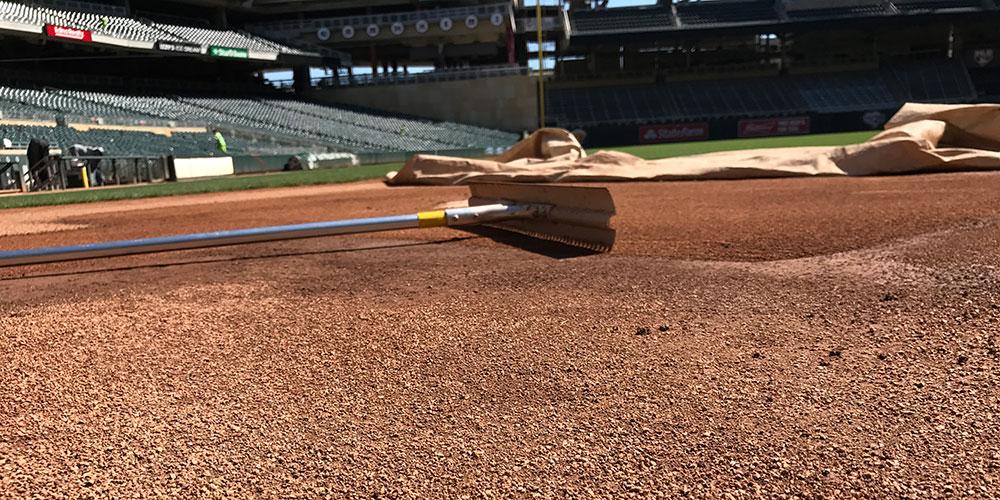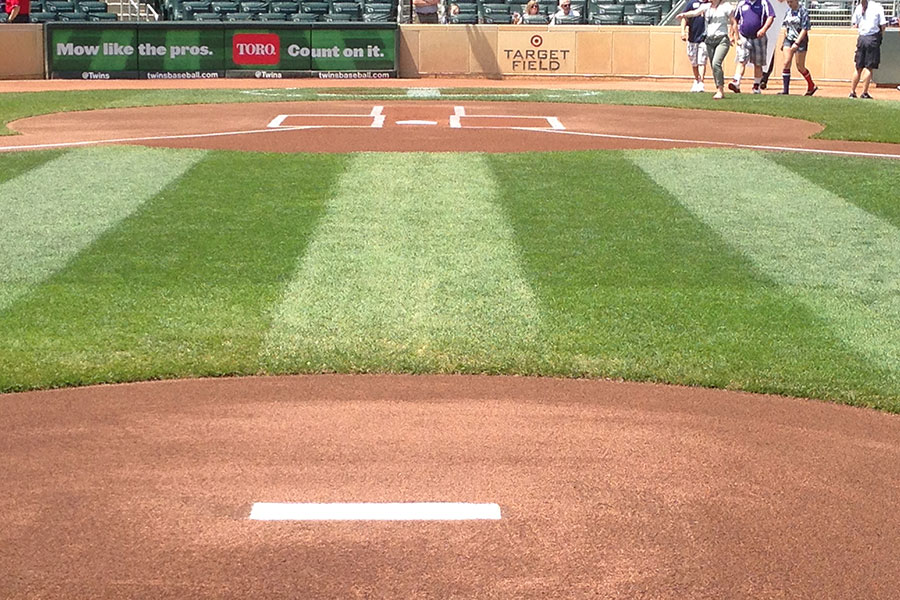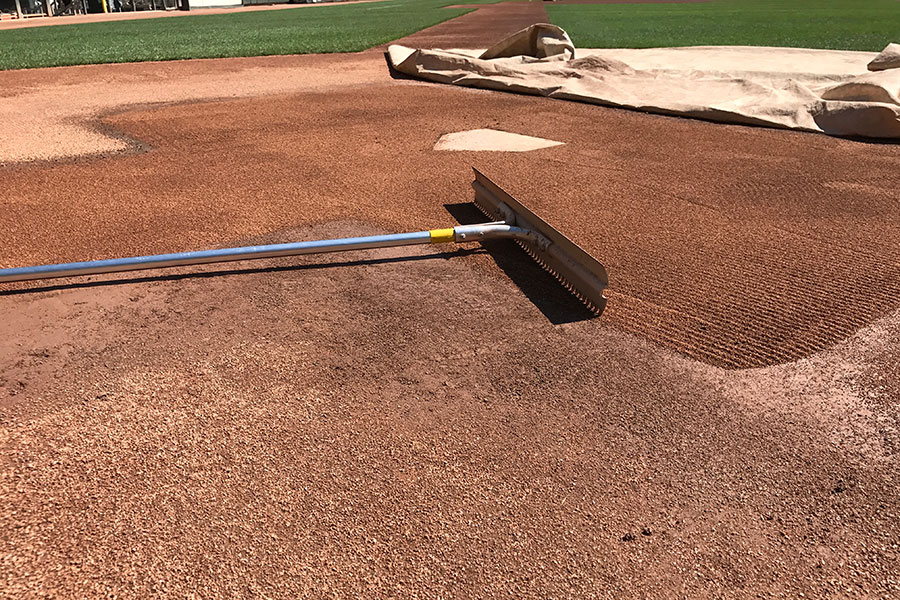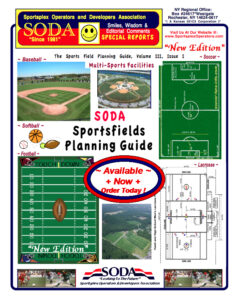
“A groundskeeper’s goal is to allow hitters and pitchers to focus on their job at hand and not worry about the surface beneath them…”
We are all groundskeepers and turfgrass managers at many different levels of baseball. All of us – myself included – spend a great deal of time working on how to grow grass and manage infield dirt to achieve the highest level of playability possible on our fields. However, the reality is that in baseball the most important aspect of the game is the interaction, the confrontation, of the hitter and the pitcher. That pitch-by-pitch matchup is what drives the game. Everything else follows in its path.
Recently, I was fortunate to be part of a conference call that included Dr. Trey Rogers from Michigan State University. He stated that one of the first things he tells his students is there is not one perfect turfgrass. I agree, Dr. Rogers is 100% correct in his assessment. So let me offer this to you: when it comes to mound and home plate clay, there is not one perfect type of clay. Beacon Athletics makes a great effort to offer the finest bagged clay options on the market. Over the past two decades I have sampled clay from pretty much every major distributor in the country. We are fortunate that there are many quality options available regionally and nationally when it comes to mound and plate clay. The variables that impact these products are climate and weather.
 “Climate” refers to the general meteorological trends in your area. “Weather” is about what is happening where you are right now. Some products perform better in moist conditions while others are more suited for a drier climate. Regardless of the product, I feel it is important to stock the clay that is ready to use in a few different ways. Going into a home stand, have a supply that is moist and ready to go, some with a moderate amount of moisture, and some that is very fine and screened but slightly on the dry side. This will allow you to have options from day to day when evaluating weather conditions as you work those areas. On a dry and sunny day, you can use the wetter clay to pack the mound and plate, then let the sun bake it a bit, letting it set prior to putting the tarp back on. If you have a cloudy and humid day, the drier clay will perform fine as you pack it into a moist base.
“Climate” refers to the general meteorological trends in your area. “Weather” is about what is happening where you are right now. Some products perform better in moist conditions while others are more suited for a drier climate. Regardless of the product, I feel it is important to stock the clay that is ready to use in a few different ways. Going into a home stand, have a supply that is moist and ready to go, some with a moderate amount of moisture, and some that is very fine and screened but slightly on the dry side. This will allow you to have options from day to day when evaluating weather conditions as you work those areas. On a dry and sunny day, you can use the wetter clay to pack the mound and plate, then let the sun bake it a bit, letting it set prior to putting the tarp back on. If you have a cloudy and humid day, the drier clay will perform fine as you pack it into a moist base.
When a hitter steps into the batter’s box and a pitcher sets himself on the pitching rubber, our goal as groundskeepers is to allow them to focus on their job at hand and not worry about the surface beneath them. When it comes to these areas, think moist and very firm. Provide a surface that allows the player to get his feet settled in and get to work. The pitcher needs to focus on the catcher’s glove, and the hitter needs to find the release point of the pitcher and focus on the baseball. We do not want them worrying about the clay beneath them at that point. But what about the overall context of the environment for both the hitter and the pitcher? What is that like and what can we do to improve it as groundskeepers?
 Any pitcher likes to feel as if he is right on top of the hitter. The stature of the mound itself plays a role, as does the proximity of the backstop wall to home plate. As a pitcher, you like to step on a mound with a properly sized and level table to work from. You also want to feel as if the slope is to specifications or steeper. A flat slope is a very discouraging thing to encounter in the first inning of a ballgame. The height of the mound in relation to home plate can vary greatly from one field to the next. This is due to the grade of the turfgrass between the mound and the plate in many cases. At the major league level, many fields have infield grass areas that are perfectly flat, which produces a 10” high mound that is a consistent 10” above the turfgrass and above home plate. This is an excellent way to have a quality infield if you have a sand-based root zone with properly designed drainage. One grading concept to consider for your turf is to have the 10-12 ft wide area of turfgrass from the mound to the plate level, while grading the rest of the infield turf with a slight slope for rain runoff. The physical makeup of the root zone would need to have acceptable drainage characteristics for this to work, as that area is prone to traffic and compaction.
Any pitcher likes to feel as if he is right on top of the hitter. The stature of the mound itself plays a role, as does the proximity of the backstop wall to home plate. As a pitcher, you like to step on a mound with a properly sized and level table to work from. You also want to feel as if the slope is to specifications or steeper. A flat slope is a very discouraging thing to encounter in the first inning of a ballgame. The height of the mound in relation to home plate can vary greatly from one field to the next. This is due to the grade of the turfgrass between the mound and the plate in many cases. At the major league level, many fields have infield grass areas that are perfectly flat, which produces a 10” high mound that is a consistent 10” above the turfgrass and above home plate. This is an excellent way to have a quality infield if you have a sand-based root zone with properly designed drainage. One grading concept to consider for your turf is to have the 10-12 ft wide area of turfgrass from the mound to the plate level, while grading the rest of the infield turf with a slight slope for rain runoff. The physical makeup of the root zone would need to have acceptable drainage characteristics for this to work, as that area is prone to traffic and compaction.
With regard to the backstop, the worst visual feeling for a pitcher is to see a clear, chain link fence behind his catcher. You feel as if home plate is 75 feet away in that case. Wherever your backstop fence may be, a pitcher likes a solid, dark wall pad in the background … the closer to the catcher the better.
The biggest home plate mistake many in the turf industry see on fields in the community is when the entire circle is graded like a dinner plate. Your goal should be for the batter’s and catcher’s boxes to be level with the turfgrass edge in front of home plate. There are two main reasons for this. First, the catcher should be able to feel he is on level ground receiving pitches and when coming up to throw. A catcher popping up to throw out a base stealer does not want to be throwing uphill, which can cause the ball to sail a bit. Second, as a hitter you want to see level dirt and turf in front of you if at all possible. Hitting from a sunken batter’s box against a pitcher high above you is not fun. As I mentioned earlier, anything we can do to help the player be more relaxed and comfortable, the better they can focus on the ball and perform well.
Finally, a word about the batter’s eye in center field. I was extremely fortunate that at my high school in the San Francisco area, the hitter’s backdrop in center field consisted of mature redwood trees. The dense evergreen growth of those trees provided an optimal batter’s eye for us as hitters. It is always unfortunate to see a field where the hitter’s backdrop is random houses or buildings of neutral colors. For the game to be played at its optimal level, hitters should have a clean, dark, solid backdrop beyond center field to help them track the baseball out of the pitcher’s hand. While a grove of evergreen trees may not always be an option, the staff at Beacon can provide you with options for a batter’s eye backdrop that will greatly improve your facility.
I hope some of these ideas are helpful and you can continue the good work you all do improving your facilities.






0 Comments